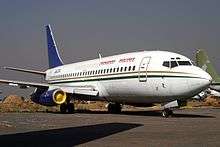Cameroon Airlines Flight 3701
Cameroon Airlines Flight 3701 was an air accident that occurred on 3 December 1995. The Boeing 737-200, registration TJ-CBE, crashed after it lost control near Douala, Cameroon. On its second approach to Douala International Airport power was lost to one engine. The accident killed 71 passengers and crew and five people were injured but survived.[1][2][3]
 A Cameroon Airlines Boeing 737-200, similar to the aircraft involved in the accident. | |
| Accident | |
|---|---|
| Date | 3 December 1995 |
| Summary | Loss of control |
| Site | Near Douala International Airport, Douala, Cameroon 3°59′43.4″N 9°42′31.8″E |
| Aircraft | |
| Aircraft type | Boeing 737-200 |
| Aircraft name | Nyong |
| Operator | Cameroon Airlines |
| Registration | TJ-CBE |
| Flight origin | Cadjehoun Airport, Cotonou, Benin |
| Destination | Douala International Airport, Douala, Cameroon |
| Occupants | 76 |
| Passengers | 71 |
| Crew | 5 |
| Fatalities | 71 |
| Injuries | 5 |
| Survivors | 5 |
Accident
Cameroon Airlines Flight 3701 took off from Cadjehoun Airport in Cotonou, Benin, on a flight to Douala International Airport. The Boeing 737-200 had 71 passengers and five crew on board and after a one-hour flight was ready to land at Douala International Airport, but as the landing gear was lowered the nose gear light showed that it was not down. The pilots called air traffic control saying that they had landing gear problems and the crew elected to abort the approach. Some minutes later they tried a second approach but the pilots did not see that the engine two was operating at high power while the No. 1 engine was not developing power. Then the aircraft went into a steep dive and crashed 6 kilometres (3.7 mi; 3.2 nmi) short of the runway in a mangrove swamp. The aircraft burst into flames, killing 71 passengers and crew. Five people survived the accident.[1]
Cause
The accident report determined the cause of the loss of control and the loss of power to engine No. 1 to be the following:
The probable cause of the accident is a loss of control during a go-around attempt made during a maneuver to reach the runway with degraded performance Seriously contributing to this:
- The detachment by structural fatigue of a first stage compressor blade of the No. 1 engine which resulted in a loss of power and destabilization of the trajectory when landing
- The late or slow execution of the go-around procedure with an unidentified single-engine configuration, leading to irreversible loss of speed.
According to Cameroon Airline's Chief Pilot (ret.) Jean Louis Angounou, interviewed in May 2009 on Le Jour Quotidien, the exact cause of the accident has never been determined because "in Cameroon, some inquiries begin but never come to an end".
References
- "ASN Aircraft accident Boeing 737-2K9 TJ-CBE Douala". Aviation-safety.net. Retrieved 4 April 2010.
- "1995-72 ACCIDENT DETAILS". www.planecrashinfo.com. Archived from the original on 10 February 2018. Retrieved 4 April 2010.
- "TJ-CBE Cameroon Airlines Boeing 737-200". www.planespotters.net. Retrieved 25 November 2019.
- Bouba, Aboubakar Siddiki (11 June 2012). "CAMEROUN, AFFAIRE MARAFA : LE MPSC INTERPELLE LES DÉPUTÉS ET PUBLIE LA LISTES DES PASSAGERS ET MEMBRES DE L'ÉQUIPAGE VICTIMES DU CRASH DU BOEING DE LA CAMAIR" [CAMEROON, MARAFA CASE: MPSC INVITES MPs AND PUBLISHES LIST OF PASSENGERS AND CREW MEMBERS VICTIMS OF CAMAIR'S BOEING CRASH]. camer.be (in French). Cameroon. Archived from the original on 10 November 2013. Retrieved 25 November 2019.
- Kingue, Edouard (25 January 2013). "Visite: Au-delà de la mission économique, Ce qui attend Paul Biya en France" [Visit: Beyond the economic mission, What awaits Paul Biya in France]. cameroon-info.net (in French). Le Messager. Archived from the original on 26 January 2013. Retrieved 25 November 2019.